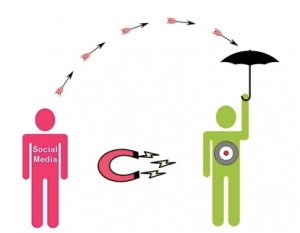In Social CRM, we are concerned with integrating social network and social media to enhance CRM practices and eventually increase customer loyalty. Here, I’d like to argue that the integration goes the other way too. In other words, while social media strategy can eventually affect customer loyalty, the design of social media strategy right now should take into consideration your company’s current customer loyalty situation.
To make my point, let’s first look at the edge a company with lots of loyal customers (what I call a high loyalty-performer) can have in today’s social web over a competitor without those loyal customers:
- Whether it’s Facebook fan page, Twitter account, or viral messages, a high loyalty performer are more likely to have a large number of fans or followers with their ears open to what the business has to say. 1.5 million Twitter users did not just wake up one day and decide to follow Dell Outlet. The brand most likely already had a top of the mind priority among these consumers.
- A large group of loyal customers also functions as an army of passionate ambassadors for the brand. As Brian Solis’ recent blog post points out, what makes something viral is not the content but the people. I wholeheartedly agree with that, and my own research on viral diffusion of content seems to echo that. One crucial condition for going viral is that people are willing to pass on the information, and who else but the loyal fans will be most likely to do that?
- A high loyalty performer is more likely to get consumers’ vote of confidence at times of uncertainty. Apple reportedly sold 300,000 iPads on the first day of its release, despite mixed reviews and the joke circling in social networks about its awkward name. Some Apple fans will literally buy anything new from Apple, whatever other people may say. This is the power of loyalty.
I hope I have convinced you that a high loyalty performer can potentially benefit more from social media. But this does not mean that medium loyalty performers or even brands with serious problems cannot have a productive social media strategy. Instead of avoiding social media altogether or blindly copying what other companies are doing, a business should adapt its social media strategy based on the loyalty level of its customers. In the table below, I lay out the recommended strategies for high, medium, and low loyalty performers in the social media space.
| Loyalty Tier | Social Media Strategy Focus | Focal Metrics |
|---|---|---|
| High Loyalty Performers (Large number of loyal customers and high emotional brand connection) |
|
|
| Medium Loyalty Performers (Mediocre customer loyalty and lukewarm brand connection) |
|
|
| Low Loyalty Performers (High customer turnover and negative brand associations) |
|
|
Eventually, your company’s social media strategy should be an adaptive and fluid system that adapts to your business situation and your customers’ needs. The ideal social media strategy will connect with your most loyal customers and build on this most important asset of the company.
